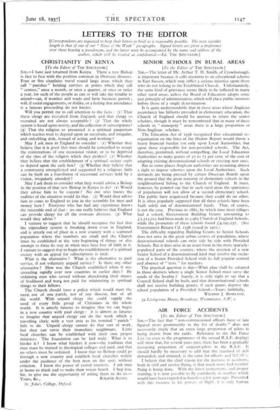SENIOR SCHOOLS IN RURAL AREAS
[To the Editor of TI1E SPECTATOR.]
SIR,—The letter of Mr. Arthur T. H. Smith, of Crowborough, is important because it calls attention to an educational scheme in East Sussex, which may inflict a serious injustice upon those who do not belong to the Established Church. Unfortunately, the same kind of grievance seems likely to be inflicted in many other rural areas, unless the Board of Education adopts some just principle of administration, which will place public interests before those of a single denomination.
It is quite understandable that in those areas where Anglican ascendancy has hitherto prevailed in elementary education, the Church of England should be anxious to retain the senior scholars, though it must be remembered that in many of these schools in " monopoly " areas there is a large proportion of Non-Anglican scholars.
The Education Act of 1936 recognised that educational re- organisation on the lines of the Hadow Report would throw a heavy financial burden not only upon Local Authorities, but upon those responsible for non-provided schools. The Act, therefore, permitted, without compelling, the Local Education Authorities to make grants of 5o to 75 per cent. of the cost of adapting existing denominational schools or erecting new ones.
But in some places Anglican authorities are assuming almost a right to impose schemes upon the Local Authorities. Such demands are being pressed by certain Diocesan Boards upon the ground that the great majority of elementary schools in the neighbourhood belong to the Church of England. It must, however, be pointed out that in such rural areas the sparseness of population will not allow of a second elementary school. The public have acquiesced because they could do no other.
It is often popularly supposed that all these schools have been built solely out of denominational funds. That, of course, is not the case. Previous to 1881, by which time most villages had a school, Government Building Grants amounting to £1,515,205 had been made to 5,965 Church of England Schools, while the promoters of these schools found £4,295,237. (See Government Return Cd. 1336 issued in 1902.) The difficulty regarding Building Grants to Senior Schools
does not arise in the great urban centres of population, where denominational schools can exist side by side with Provided Schools. But it does arise in an acute form in the more sparsely- populated parts of the country, where the erection of a new Senior School of a denominational kind may involve the exclu- sion of a Senior Provided School with its full popular control and absence of " tests " for teachers.
The practical question is this—What plan shall be adopted in those districts where a single Senior School must serve the needs of the locality ? Surely, it is only right to say that a Council School shall be built, and that denominational schools shall not receive building grants, if such grants deprive the school population of a Provided School.—Yours faithfully, WILFRID J. ROWLAND.
39 Livingstone House, Broadway, Westminster, S.W. r.














































 Previous page
Previous page